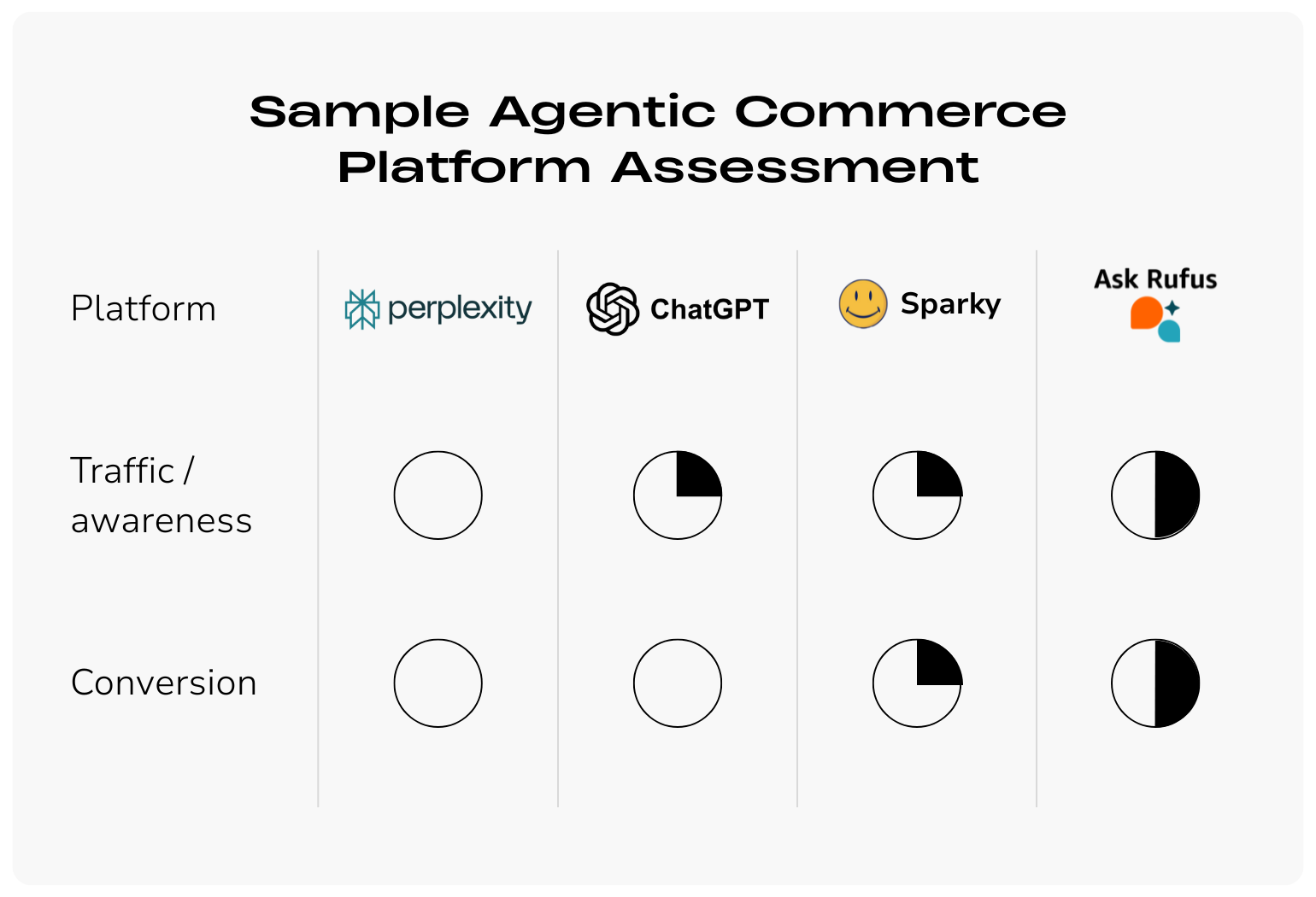
Last week, Walmart made headlines announcing that ChatGPT users will soon be able to purchase products directly from the Walmart app when recommended by the AI. This follows similar Agentic Commerce capabilities announced for Shopify and Etsy last month.
While there’s plenty of buzz around the Walmart–ChatGPT integration, there’s still much we don’t know:
Brands that start preparing their organizations for the world of AI Shopping Assistants now will have a major advantage — much like how early adopters of Amazon gained discoverability and sales advantage in the world of marketplaces.
According to SimiliarWeb, Walmart is already receiving significant referral traffic from ChatGPT. In August, nearly 20% of Walmart’s referral clicks came from ChatGPT, up from 15% in July — now approaching 1% of total site traffic (Digiday).
And that’s before Instant Checkout even goes live.
It’s also important to recognize that both Walmart and Amazon already have their own AI shopping assistants — Sparky and Rufus. Considering that Amazon is a global leader and Walmart is a critical retailer in North America, these two companies are essential for generating the majority of traffic, conversion, and sales for CPG brands. Amazon Rufus has the ability to perform complex shopping research and recommendations, such as recommending multiple products within an ideal budget range, for situations like planning a party. Therefore, prioritizing success with Amazon and Walmart should be the primary focus for most CPG brands.
At least, today.
The good news: If you optimize for Walmart and Amazon’s AI shopping assistants, you’ll be well positioned as other LLMs (like ChatGPT) enable direct purchasing through retailers.
1. Define Your Agentic Commerce Strategy
Before pivoting your organization’s focus to Agentic Commerce, you need a clear strategy tying it back to brand objectives. Start with the question: “Should we invest at all? What must be true for us to invest in each Agentic Commerce platform?” (ie. ChatGPT, Perplexity, Rufus, Sparky, etc.) The decisions will vary by category and brands, but main consideration should include:
A recent study by the University of Hamburg and the Frankfurt School of Finance & Management found that referral traffic from affiliate links was 86% more likely to convert than traffic from ChatGPT, while organic search outperformed ChatGPT by roughly 13%. Although data on this hasn’t yet been published, it’s reasonable to assume that ChatGPT referrals convert at lower rates than traffic generated by Amazon’s and Walmart’s own AI shopping assistants. (Modern Retail)
Google has long been the powerhouse for driving traffic to brands — and ChatGPT is quickly catching up. But with both platforms, brands must ask: what's the value of traffic if it doesn't convert? Before investing, brands need to take a data-driven approach to determine if the juice is really worth the squeeze.
— Jamie Dooley, VP Global Strategic Solutions, Profitero+

2. Define Your Agentic Commerce Playbooks
Once you’ve identified your priority platforms, understand what it takes to influence them.
As an example, most retailer AI models reward the same fundamentals:
Doing all of the above may require incremental investment beyond what you have already budgeted for digital shelf optimization. Before scaling, run test & learn pilots to identify which optimizations move the needle using traffic, conversion and sales as KPIs. Start with Amazon and Walmart, where data depth is richest.
3. Define Your Agentic Commerce Operation Model
Once you’ve built playbooks, you’ll need to define how to operationalize them.
Ask: “What insights will drive repeatable optimization, and who’s accountable for taking action?”
If you already have a digital shelf operating model, you’re most of the way there — since content accuracy, reviews, in-stock and pricing should already be core accountabilities.
Here’s what you’ll need to think about for the next generation of your tech stack:
Once you’ve mapped out your operating model, you may need to revisit your technology and data stack to ensure it maps to the right jobs to be done. To avoid tech proliferation and fragmentation, investigate what your current trusted providers are able to provide.
If you haven’t yet mastered the basics of optimizing the digital shelf, then you should seriously question whether you’re ready to tackle the world of Agentic Commerce. But it’s not too late to implement practices that factor Agentic Commerce into a digital shelf operations model. It should be an evolution, not a revolution of good digital shelf hygiene.
Our Advisory team is helping clients prioritize the right AI channels, define operational playbooks, and uplevel organizational readiness through workshops — ensuring Agentic Commerce complements (not fragments) current digital shelf programs. In the process, we’re recommending content optimizations to help brands both win with AI as well as traditional SEO, which should always be considered together. Finally, we’re using our traffic, conversion, and sales data to power test-and-learn programs that validate what AI content optimization best practices really work. Stay tuned for our forthcoming research on what we have learned so far and check out these early learnings here.
Agentic Commerce represents the next major evolution of digital retail — but success won’t come from chasing hype. It will come from operational excellence, data discipline and a clear strategy that connects today’s fundamentals to tomorrow’s AI-powered discovery.
As the industry’s #1 ranked digital shelf provider, Profitero+ is ready to help.


